The Blake School (Minneapolis)
The Blake School is a private, coeducational, nonsectarian[3] PK–12 college preparatory day school, established in 1900. Blake is located on three campuses around the Twin Cities area of Minnesota: the upper school (9–12) is in Minneapolis; administration offices, middle school (6–8) is in Hopkins, Minnesota, and half of the lower school is also in Hopkins, Minnesota connected to the middle school; and the other half of the lower school is in Wayzata, Minnesota.
| The Blake School | |
|---|---|
 | |
| Location | |
Minneapolis , United States | |
| Coordinates | 44.9698000°N 93.2929000°W[1] |
| Information | |
| Type | Private, College-prep, Day |
| Established | 1900 |
| Head of school | Anne E. Stavney |
| Faculty | 162 |
| Grades | PK–12 |
| Gender | Coeducational |
| Enrollment | Approx. 1,400[3] |
| Average class size | 15–16[3] |
| Student to teacher ratio | 9:1[3] |
| Campus |
|
| Color(s) | blue and green |
| Athletics conference | Independent Metro Athletic Conference (IMAC) |
| Mascot | Cyrus the Bear[4] |
| Website | blakeschool |
History
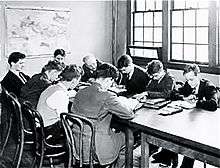
During the early 20th century, two schools were founded in Minneapolis to prepare students for elite colleges in the Northeast:[4] the Blake School for boys and Northrop Collegiate School for girls. A third school, Highcroft Country Day School serving students of both sexes, was incorporated during the migration to Minneapolis suburbs. In 1974, the three schools merged to become the Blake Schools, with its first coeducational class graduating in 1975.[4]
Blake
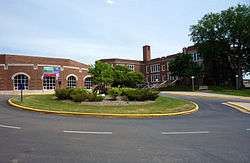
In 1907, William M. Blake established the Blake School, a private, preparatory school for boys, in Minneapolis. Three years later, Charles C. Bovey, a local businessman, wanted to reform Blake, and put it on the same plane as Eastern preparatory schools.[4]
With help from William Blake, Bovey asked sixteen other local business leaders to contribute $2,500 each towards the school's first capital drive. In 1911, these original guarantors hired Charles B. Newton, a Princeton and Harvard alumnus, to replace William Blake as headmaster. Newton envisioned a school "not only for the wealthy, but for the worthy." The school incorporated on May 5, 1911, with all but two guarantors serving on the Board of Trustees. In 1912, their pooled resources enabled the construction of a new building in suburban Hopkins, with the site, now known as Blake Campus, being the current home of the middle school and one of the two lower school campuses.[4]
Northrop

In 1900, Zulema A. Ruble, a Smith College alumna,[5] and Carrie Bartlett established Graham Hall, a private school for girls, in Minneapolis. In 1914, a group of Minneapolis leaders purchased Graham Hall and incorporated it as Northrop Collegiate School. In 1917, the school relocated within Minneapolis, with the site, now known as Northrop Campus, being the current home of the upper school campus.[4]
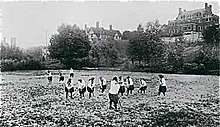
Highcroft
In 1958, Sage Cowles, wife of John Cowles, Jr., along with two friends,[6] established Highcroft Country Day School, a private, coeducational, nonsectarian K-9 school in Wayzata. Highcroft was designed to provide students in the far western suburbs (at the time) of the Twin Cities with an education near home. In 1960, the school building was constructed on land purchased and donated to the school, part of which was the former Highcroft estate in Wayzata, with the site, now known as Highcroft Campus, being the current home of the other lower school campus.[4]
Preservation and present
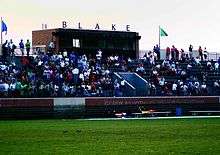
In addition to retaining the original sites of the three schools as part of the campuses of the Blake School, the school also carries on other traditions, such as:[4]
- from the Blake School for the boys – strong speech and debate programs, which are still maintained as an ongoing graduation requirement
- from Northrop Collegiate School – strong drama program, mascot of bears, along with the school color of blue
- from Highcroft Country Day School – growing athletic program for both boys and girls, along with school color of green.
The current head of school is Dr. Anne Stavney.[3]
Academics
Blake promotes a well rounded, liberal arts education encouraging involvement in academics, athletics, and the arts. The Blake school has a goal of being a preparatory school for college, also known as a prep school. The school serves approximately 1,400 students in prekindergarten through twelfth grade, with an average classroom size of 15–16 students, and average graduating class size of 130. The school's student-adult ratio is 9:1.[3]
It takes 22 credits to graduate from The Blake School, with a minimum course load of five courses each semester.[7] The Blake School also offers numerous global citizenship programs.[8]
Accreditation
Blake is accredited by the Independent Schools Association of the Central States (ISACS), and is a member of the National Association of Independent Schools (NAIS), The College Board, National Association of College Admissions Counselors (NACAC), and the Cum Laude Society.[9]
Recognition
Blake has received numerous accolades in recent years, including:
- U.S. Department of Education – Blue Ribbon School, 1989–90, 1992–93, 1993–94[10]
- The College Board – "Exemplary AP English Literature and Composition Programs", 2007[11]
- Wall Street Journal – "How the Schools Stack Up" (ranking of 41- above Hotchkiss School, Deerfield Academy, Sidwell Friends School in Washington D.C., Princeton Day School, and Dalton School in New York, for high schools with the best record of graduates attending eight top universities), 2007[12]
- Character Education Partnership – National School of Character, 2009[13]
- Mpls St.Paul Magazine – in school diversity and inclusion efforts, 2010[14]
- MN Monthly Magazine – for leadership training of its students, 2012; Built to Lead
In 2011, Blake won the Minnesota Middle School Science Bowl, and was a competing school in the U.S. Department of Energy's National Science Bowl,[15] winning the Hydrogen Fuel Cell Car Race portion.[16] In 2015, it won the Department of Energy's Minnesota High School Science Bowl and proceeded to compete at the national level in Washington D.C.
Blake is also home to one the most active and successful high school debate programs in the entire country, having won several prestigious national championships, including the National Speech and Debate Association National Tournament, the National Debate Coaches Association National Tournament, and the Tournament of Champions. They are also the first school to qualify debaters to the Tournament of Champions in every event. Every December, Blake hosts the John Edie Debate Tournament, one of the largest regular-season speech and debate tournaments in the country.[17]
Athletics
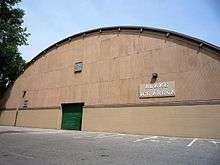
Blake competes in the Independent Metro Athletic Conference (IMAC) and formerly in the Tri-Metro Conference,[18] which is part of the Minnesota State High School League. The school athletic teams are named the Blake Bears.[4] The school offers twenty-eight sports, and fields over fifty athletic teams. The school also recognizes four club sports, including Ultimate Frisbee, Equestrian Team, Sailing, and the Stepps Dance Team.[19] They are also recognized for having their hockey team in a cameo for the 1996 Disney movie D3: The Mighty Ducks when the movie was shot on set at Blake's Hopkins campus hockey arena; they came from behind down 9–0 to tie the Ducks 9-9, with 9 third period goals.
History
Blake won the Minnesota State High School League Challenge Cup, which awards schools based on their success in section and state fine arts and athletics tournaments, in 2005, 2007, 2009, 2012, 2013, 2014 and 2015[20] – more than any other school in state history – and was runner-up in 2006, 2008 and 2010, and placed third in 2011.[20] In addition, many Blake alumni go on to play sports at the collegiate level, and some have even been drafted by professional sports franchises in the NHL, NFL, and MLB.
Notable alumni
- Michael Ankeny (2009) - Alpine Skier
- Charles Baxter (1965)[21] – author of National Book Award nominated The Feast of Love (2000)
- Dani Cameranesi (2013) – Forward for U.S. women's hockey team at 2018 Winter Olympics[22]
- Jack Dalrymple (1966)[23] – former Governor of North Dakota
- Tom Davis (1970)[24] – Emmy-winning comedy writer and performer
- Mark Dayton (1965)[25] – U.S. Senator from Minnesota, 40th Governor of Minnesota, heir to Dayton's and Target Corporation, first husband of Alida Rockefeller Messinger
- David T. Ellwood (1971)[24] – Dean of Harvard John F. Kennedy School of Government
- Al Franken (1969)[24][25] – U.S. Senator from Minnesota, satirist, comedian, author, screenwriter, Saturday Night Live television performer, political commentator, radio host
- Dave Goldberg (1985)[26] – businessman, CEO of Survey Monkey
- Poppy Harlow (2001)[27] – CNN reporter
- Thomas B. Heffelfinger (1966)[28] – former U.S. Attorney of Minnesota
- George Roy Hill (1939)[24] – Oscar-winning director of Butch Cassidy and the Sundance Kid
- Steve Kelley (1971)[29] – Minnesota State Senator, 2000 U.S. Senate candidate, attorney
- Eleanor de Laittre – artist
- Katrina Lake – CEO of Stitch Fix
- John Hugh MacMillan – businessman[30]
- Whitney MacMillan (1947)[24] – CEO of Cargill
- Marcia McNutt (1970)[24] – president National Academy of Sciences[31]
- Kent Patterson (2007) - NHL player
- Marcus Peacock (1978)[32] – former Deputy Administrator U.S. Environmental Protection Agency
- Robert M. Pirsig (1943) - philosopher, author of Zen and the Art of Motorcycle Maintenance: An Inquiry into Values (1974)
- Jim Warden (1972)[33] - Goaltender for U.S. men's hockey team at 1976 Winter Olympics
- J.T. Wyman (2004)[34] – NHL player
References
- U.S. Geological Survey Geographic Names Information System: Blake School
- U.S. Geological Survey Geographic Names Information System: Blake School
- "Blake at a Glance". The Blake School. Archived from the original on July 21, 2011. Retrieved April 21, 2011.
- "The Blake School: A History". The Blake School. Archived from the original on July 21, 2011. Retrieved May 25, 2011.
- Smith College Bulletin: Alumnae Register 1916–1917. Smith College Alumnae Association. 1917. Retrieved June 11, 2011.
- "Sage Cowles and John Cowles, Jr.— 2005–06 Louis W. Hill, Jr. Fellows". Grotto Foundation. Retrieved June 11, 2011.
- "Academics: The Blake School Graduation Requirements". The Blake School. Archived from the original on July 21, 2011. Retrieved May 25, 2011.
- "Programs & Services: Global Citizenship at Blake". The Blake School. Archived from the original on April 25, 2011. Retrieved May 25, 2011.
- "The Blake School & Accreditation". The Blake School. Archived from the original on April 25, 2011. Retrieved May 25, 2011.
- "BLUE RIBBON SCHOOLS PROGRAM: Schools Recognized 1982–1983 Through 1999–2002" (PDF). U.S. Department of Education, Office of Educational Research and Improvement. Archived from the original (PDF) on March 26, 2009. Retrieved May 25, 2011.
- "2007 Advanced Placement Report to the Nation" (PDF). The College Board. Retrieved May 25, 2011. p. 32
- "High Schools: How the Schools Stack Up". The Wall Street Journal. December 28, 2007. Retrieved May 25, 2011.
- "2009 NSOC Award Winners & Finalists: 2009 National Schools of Character". Character Education Partnership. Archived from the original on July 25, 2011. Retrieved May 25, 2011.
- Hornbacher, Marya (September 2010). "Blake's True Colors". mspmag.com. Retrieved May 25, 2011.
- "NATIONAL SCIENCE BOWL 2011: National Event Program" (PDF). U.S. Department of Energy. Retrieved June 11, 2011., pp. 17 and 23
- Pillitteri, Abigail (May 1, 2011). "Plenty of Excitement at the Hydrogen Fuel Cell Car Race". U.S. Department of Energy Office of Science. Retrieved June 20, 2011.
- School, Blake (May 1, 2015). "Speech and Debate". The Blake School. Retrieved June 20, 2011.
- "Tri-Metro: Member Schools". Tri-Metro Conference. Retrieved May 25, 2011.
- "Upper School Program: Welcome to The Blake Upper School Athletic website!". The Blake School. Archived from the original on July 21, 2011. Retrieved May 25, 2011.
- "Challenge Cup: THE CUP OF CHAMPIONS". Minnesota State High School League. Retrieved May 25, 2011.,
- "One Book, One Blake". The Blake School. Archived from the original on July 21, 2011. Retrieved June 11, 2011.
- "Dani Cameranesi: Career Statistics". USCHO.com. Retrieved 14 April 2019.
Previous team: Blake School
- "BLAKE ALMA MATTERS: February 2011" (PDF). The Blake School. Archived from the original (PDF) on September 29, 2011. Retrieved July 17, 2011.
- "Alumni Awards: Outstanding Alumni Award". The Blake School. Archived from the original on May 19, 2011. Retrieved May 25, 2011.
- Davey, Monica (October 12, 2009). "Minneapolis's Elite Pursue Pranks by Lawsuit". New York Times. Retrieved May 27, 2011.
- "David Goldberg, Silicon Valley CEO with deep ties to Minneapolis, dies at 47". Minneapolis Star-Tribune. Minneapolis. May 2, 2015. Retrieved 3 May 2015.
- "The Blake Bulletin: Alumni Album – Students for a Day: Alumni Academy at The Blake School" (PDF). The Blake School. Archived from the original (PDF) on July 21, 2011. Retrieved June 11, 2011., p. 37
- "The Blake Bulletin: Alumni Album – Reunion 2006" (PDF). The Blake School. Archived from the original (PDF) on July 21, 2011. Retrieved June 11, 2011., p. 30
- "Minnesota Legislators Past & Present: Kelley, Steve P." Minnesota Legislative Reference Library. Retrieved May 25, 2011.
- "John H. "Hugh" MacMillan III". Legacy. Retrieved November 23, 2014.
- "Marcia McNutt Elected 22nd NAS President; New Treasurer, Council Members Chosen" (Press release). National Academy of Sciences. February 16, 2016. Archived from the original on February 21, 2016. Retrieved February 23, 2016.
- "Biography – Deputy Administrator Marcus C. Peacock". U.S. Environmental Protection Agency. Retrieved 7 August 2012.
- Mulvoy, Mark. "Sun child in the icy nets".
- "ALUMNI NEWS: J.T. Wyman '04 in First Year of Professional Hockey (Hockey: Boys Varsity)". The Blake School. Archived from the original on July 21, 2011. Retrieved May 27, 2011.